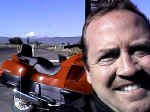Motorcycle riders have their reasons for buying that first bike. There is no
single demographic or description that fits all bike riders. In fact, the
popularity of motorcycles is growing, and you may be shopping for a bike for any
number of many good reasons.
The
Thrill
Driving a
motorcycle is different than sitting behind the
wheel of your car. Motorcycles offer you a more intimate driving experience―with
the road just inches from your feet and the wind blowing past your face.
Often, driving to work or school is just a chore you endure because it is
your responsibility to make that commute every day. If you can spice up that
ride, just a little, by connecting more with the driving experience then you
might want to consider getting a motorcycle.
The thrill of driving a motorcycle, balancing the two wheels on the pavement
while riding atop the powerful engine, is a whole new driving experience. What
was once a routine drive becomes an adventure.
And you can mix up the thrill even more by traveling on your motorcycle.
Looking for a new way to see the country? Traveling on a touring bike or cruiser
is a fantastic experience filled with adventure, newness, and fun.
Speed and
Power
Motorcycles offer drivers a lot of speed and power that can't usually be
found in a car or truck. If you are craving speed and power, then you may want
to look at sports bikes with large engine capacities.
Experienced mechanics or even weekend hobbyists are always looking for new
ways to explore equipment. Motorcycles come in so many different designs and
styles that you can shop for a bike based on power, speed, drive, and
transmission.
You might even develop such an appreciation for the motorcycle that you
collect more than one bike.
Fuel
Efficiency
Fuel prices can drain off as much as 10% of your monthly budget if you drive
your car a lot. Motorcycles, on the other hand, can get upwards of 80 miles per
gallon―that is real fuel savings.
Today, drivers are jumping on motorcycles as a way to keep down their
gasoline spend. If you are a beginner rider buying a bike to increase your miles
per gallon, consider taking a
motorcycle safety course to introduce you to
driver safety.
Fuel efficiency varies from bike to bike, depending on the size of the engine
and the bike design. If your reason for buying a motorcycle is fuel savings,
then you'll want to pay careful attention to the fairings―plastic used to
improve aerodynamics.
Custom, Culture, and Region
Finally, some people just drive motorcycles. Geographically, there are
regions in the country where motorcycles are extremely common. If you live in
one of these regions, then buying a motorcycle is as natural to you as gardening
or skiing is to someone else.
Getting around is easier on a motorcycle if you live in a congested area
where traffic bogs down the roadways. You might consider a small engine or moped
to help you maneuver through urban areas.
If you are lucky enough to live in a scenic part of the country (rural or
seaside), then you may want to buy a motorcycle to better view the natural
beauty. Racing down a windy road with a picturesque view and a friendly
passenger is a lovely way to connect with your environment.
The reasons for buying a motorcycle are varied, ranging from economics to
pure pleasure. As the population ages and total leisure time grows, you may even
find more
motorcycle drivers on the road.
Regardless of whatever motivates you to buy that first bike, select it
carefully and always put safety first.
By dmv.org
http://www.dmv.org/how-to-guides/motorcycle-buying-reasons.php
 Ever seen a guy all bundled up with his jacket on and a smile on his face - when it's ninety eight degrees outside?
Ever seen a guy all bundled up with his jacket on and a smile on his face - when it's ninety eight degrees outside?


